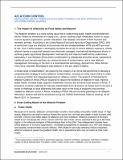AFLATOXIN CONTROL: BACKGROUND AND KEY PRINCIPLES AS WE WORK TOWARDS A HOLISTIC APPROACH FOR AFLATOXIN CONTROL IN AFRICA
| dc.contributor.author | PACA | |
| dc.coverage.spatial | ETHIOPIA | en |
| dc.date.accessioned | 2019-02-26T06:54:31Z | |
| dc.date.available | 2019-02-26T06:54:31Z | |
| dc.date.issued | 2011-03 | |
| dc.identifier.citation | Alflatoxin Control in Africa : Background paper | en |
| dc.identifier.uri | http://archives.au.int/handle/123456789/4984 | |
| dc.description.abstract | The Aflatoxin problem is a cross-cutting issue that is undermining public health and development efforts. Aflatoxins themselves are highly toxic, cancer causing fungal metabolites known to cause immune-system suppression, growth retardation, liver disease, and death in both humans and domestic animals. According to the United Nations Food and Agriculture Organization (FAO), 25% of world food crops are affected, and countries that are situated between 40ºN and 40ºS are most at risk. Over 5 billion people in developing countries are at risk of chronic aflatoxin exposure. Unless aflatoxin levels in crops and livestock are effectively managed, international development efforts to achieve greater agricultural development, food security and improve health will be undermined, particularly in sub-Saharan Africa where contamination is widespread and often acute. Inexpensive, traditional post-harvest practices can reduce the level of contamination, and a new aflatoxin management technology in the form of a local beneficial technology, derived from native African micro-flora, has been developed to fight aflatoxin in the soil, where it begins. | en |
| dc.format.medium | en | |
| dc.language.iso | en | en |
| dc.publisher | PACA | en |
| dc.subject | Aflatoxin control, background paper, food safety, trade, public health | en |
| dc.title | AFLATOXIN CONTROL: BACKGROUND AND KEY PRINCIPLES AS WE WORK TOWARDS A HOLISTIC APPROACH FOR AFLATOXIN CONTROL IN AFRICA | en |
| dc.title.alternative | Background on Aflatoxin control | en |
| dc.type | Research Paper | en |
| au.location.print | Addisababa | en |
Files in this item
This item appears in the following Collection(s)
-
Partnership for Aflatoxin Control in Africa (PACA) collection [53]
This Collection contains documents and information materails about the Partnership for Aflatoxin Control in Africa (PACA). PACA is a collaboration that aims to protect crops, livestock, and people from the effects of aflatoxins.

